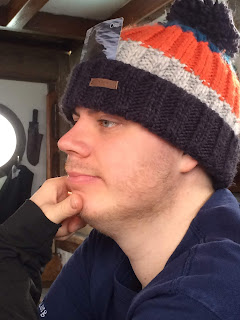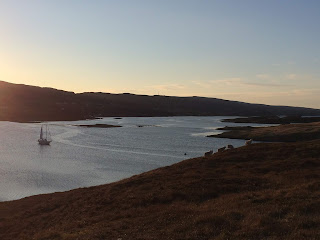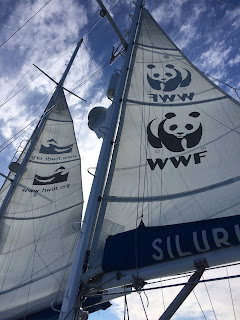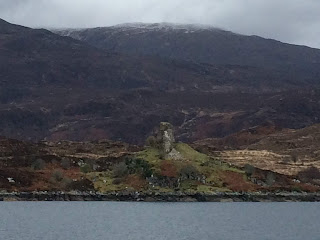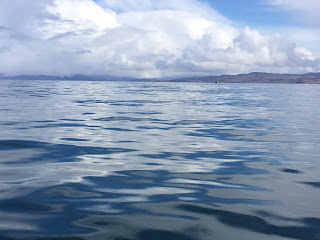Sad farewells to our little ‘family’. We had an hour or so to look round Tobermory when we arrived yesterday before deep cleaning the boat (not the bilges, thank goodness - remarkably dry bottom compared to Sea Dragon) and all had showers at the marina (limited water on board, so only one ship’s shower each during the trip) and then went out for a meal together. After breakfast together this morning Becky gave us a little slide show of memorable photos - unfortunately her computer went weird so we didn’t get to see the presentation of photos, data and charts etc that she had prepared for us, however we’ll get that individually soon (which should be great for doing talks).
I think some of us were a bit disappointed that we didn’t see any whales or dolphins and only a few harbour porpoises and seals. However, for the Hebridean Whale and Dolphin Watch the absence of sightings during the NATO exercises was highly significant. It’s rare not to see dolphins and whales normally.
We did find this Whale vertebrae on Sanday, probably from a juvenile.
I was curious as to what happens to these creatures during the exercises, where have they gone? What impact does having to leave make on both their own well being and on the areas they have abandoned.
Our science officer, Becky, two fees if the Minke Whales that would normally be arriving now, are delaying their arrival and the dolphins are just going somewhere else. She was concerned about the resident harbour porpoises; where are they going and how are they impacted by abandoning their normal foraging grounds for about 2 weeks? They’re not very big, an inability to feed for 2 weeks could have a big impact.
My other query was the impact on the affected areas of cetaceans being absent for two weeks or more. Becky wasn’t sure about this directly, however she pointed out that it is still unknown how sonar affects fish, and fish populations. If adversely, this would have a direct impact on the seabirds - and of course we are heading into breeding season.
As I was saying to one of the other volunteers, in a way it was good that we didn’t see the large sea mammals or numbers of smaller ones that should be present because it justified the purpose of our trip, it reinforced our hypothesis that the navy’s use of sonar is detrimental to local cetacean behaviour. Which is what we were there for and why we chose the Silurian Joint Warrior expedition rather than the whale and dolphin monitoring trips later in the spring and summer.
An unexpected experience for me was also around seeing the warships and reflecting on the reason for their presence. Although we only saw 7 ships (and several jets, couple of carrier planes and couple of helicopters) there may have been as many as 50 in the area (hard to tell as they have their AIS switched off ie they are in hiding). They come from about a dozen NATO countries converging on the Hebridean seas to play war games. This got me thinking why?
Who are our enemies? These warships would be useless against aliens so basically they are aimed at our fellow human beings. This seems bonkers in our current age of emigration and investments (how much of Britain is now owed by Russians, Chinese, Kuwait etc), international travel (how can people visit Russia or China as tourists and see them equally as enemies?), international commerce/employment and natural disasters where people are translocating world wide.
Back to my own work, the impact of plastics on sea life is now unquestionable, with sea bird hatchlings dying of starvation and dehydration, stomachs full of plastic, whales washed up on beaches around the world with stomachs full of plastic, almost all shell fish contaminated with mice plastics and the latest research on the presence and rapid uptake of nano plastics (nanometer sized) in scallops.
One of the most disturbing facts I learned on this trip is that the West highland’s coast community of Orcas haven’t produced any young for several years. An autopsy on a dead whale from the group revealed the blubber contained very high levels of persistent organic pollutants (POPs), notably PCB’s. We learned on eXXpedition two years ago that POPs mimic oestrogens and are chemically attracted to plastic particles. The west coast orcas are apex predators feeding largely on seals, which in turn are feeding on large fish which feed on smaller fish etc. Therefore, the orcas are bioaccumulating POPs that have made their way over years, possibly decades, up the food chain. The other resident population of orcas in the Hebrides eat mostly mackerel which will have accumulated less toxics due to shorter life spans and food chain.
I also hadn’t really appreciated that cetaceans are the bioengineers of our oceans, their behaviours and feeding basically ‘manage’ the marine ecosystems. Therefore, the health of cetaceans reflects the health of our oceans.
Standing on deck for hours every day, scanning the waters, provides plenty of time to reflect on the importance of our oceans. They cover most of our planet, they provide our drinking water, they connect to our bodies, they clean our air, they are the home of our distant mammalian relatives. Humans have always had a profound respect, and even communication with cetaceans. The recent interaction between Chris Packham and the grey whale on Blue Planet Live demonstrates that the relationship is probably reciprocated.
So I’ve come away with a whole wealth of experience and information to assimilate, share and build upon. I wonder what will be the next step?




